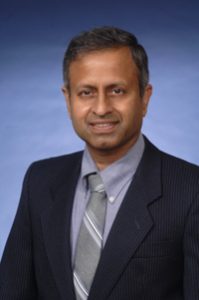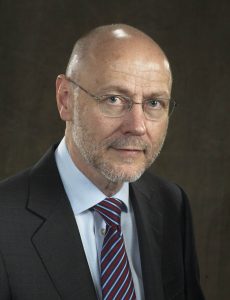Plenary Speakers
Title: Models and Modularity: A Modern Manufacturing Perspective
Abstract: Manufacturing is a process of shaping and transforming raw materials into finished goods. All manufacturing processes can be viewed as combinations of physical and chemical processes that can be modeled mathematically using physical and chemical laws, and modularized into unit manufacturing processes. In modern manufacturing, we see an additional need to model the information content of these processes. In this talk, I will describe this emerging need driven by automation, and how the manufacturing process information can be modeled, modularized, and composed to enable smart manufacturing.
Biography: Dr. Vijay Srinivasan is the Chief of the Systems Integration Division in the Engineering Laboratory at the National Institute of Standards and Technology (NIST), U.S.A. Dr. Srinivasan comes to NIST from IBM, where he was the chief standards and solutions officer for Product Lifecycle Management (PLM); and program manager for PLM Research, Standards and Academic Programs at IBM. Before that, he was a line manager in IBM’s T.J. Watson Research Center leading research in the areas of geometric modeling, CAD/CAM, robotics, standards for geometric dimensioning and tolerancing, and data exchange. Dr. Srinivasan also served as an adjunct professor of mechanical engineering at Columbia University, where he taught geometric modeling & computations and integrated product development. He is the current Chairman of the US Technical Advisory Group to ISO/TC 213. Dr. Srinivasan is a Fellow of the American Society of Mechanical Engineers (ASME) and the American Association for the Advancement of Science (AAAS).
Dr. Dawn Tilbury, Univ. of Michigan
Title: Virtual Fusion: Combining simulations with operations to improve manufacturing system control
Abstract: Revolutionary computing technologies are driving significant advances in the manufacturing domain. High-fidelity simulations and virtual design environments allow unprecedented opportunities to test and validate systems before they are built, reducing overall design time and cost. Big Data streaming from the factory floor can be collected over high-speed networks, and stored in large-scale server farms (such as cloud-based systems). Comparison of key performance indicators between the expected or simulated system and the actual physical system can enable improved analytics, leading to increased performance. This talk will describe how the integration of simulation and plant-floor data can enable new control approaches that are able to optimize the overall performance of manufacturing systems.
Biography: Dawn M. Tilbury is currently the Associate Dean for Research in the College of Engineering, University of Michigan. She received the B.S. degree in Electrical Engineering, summa cum laude, from the University of Minnesota in 1989, and the M.S. and Ph.D. degrees in Electrical Engineering and Computer Sciences from the University of California, Berkeley, in 1992 and 1994, respectively. In 1995, she joined the Mechanical Engineering Department at the University of Michigan, Ann Arbor, where she is currently Professor, with a joint appointment as Professor of EECS. Her research interests include distributed control of mechanical systems with network communication, logic control of manufacturing systems, reliability of ground robotics, and dynamic systems modeling of physiological systems. She was elected Fellow of the IEEE in 2008 and Fellow of the ASME in 2012, and is a Life Member of SWE.
Dr. Frank Allgöwer, Univ. of Stuttgart
Title: Networked and optimization-based control for Industry 4.0: Which way to go?
Abstract: With the vision of the smart factory of the future, termed Industry 4.0 in Germany, the manufacturing industries are currently undergoing a fundamental new orientation on the basis of the Cyber-Physical Systems and Internet of Things and Services paradigms. All parts along the manufacturing chain are nowadays equipped with embedded computing, communication and networking capabilities and are expected to interact in an optimal way towards the goal of an energy and resource efficient, save and reliable production process. Through decentralized optimal decision-making and an appropriate communication among the networked individual parts, the whole production process of the future is expected to operate optimally. In this presentation the challenges and opportunities of Industry 4.0 for the field of automatic control are discussed. We will in particular investigate the potential impact of networked and optimization-based control for the fourth industrial revolution and will argue that some new developments in the control field, especially connected to distributed economic model predictive control, appear to be ideally suited to have a potential impact in the new Industry 4.0 environment.
Biography: Frank’s main interests in research and teaching are in the area of systems and control with a current emphasis on the development of new methods for optimization-based control, networks of systems and systems biology. Frank received several recognitions for his work including the IFAC Outstanding Service Award, the IEEE CSS Distinguished member Award, the State Teaching Award of the state of Baden-Württemberg, and the Leibniz Prize of the Deutsche Forschungsgemeinschaft. Frank served as IEEE CSS Vice-President for Technical Activities over the last years and is President-elect of the International Federation of Automatic Control. He was Editor for the journal Automatica from 2001 to 2015 and is editor for the Springer Lecture Notes in Control and Information Science book series and has published over 300 scientific articles. Since 2012 Frank serves as Vice-President of the German Research Foundation (DFG).
Title: Intuitive Robotics – a paradigm shift in interacting with industrial robots.
Abstract: The new generation of collaborative robots target market segments that have little or no experience in applying industrial robots. To be successful in this market, new ways of human -robot interaction will be required. New technology, such as augmented reality, will make it possible to apply methods on the shop floor that until now has only been available off-line in simulation systems. At the same time, existing shop floor methods, such as lead-through programming, will become available in simulated environments. The result will be a paradigm shift in robot programming as well as a complete rethink of the user experience for everyone involved in the application of industrial robots. This presentation will outline how robot vendors can leverage strong existing capabilities in programming and simulation tools to make challenging tasks intuitive.
Biography: Bertil Thorvaldsson is the Global Product Manager in the Industrial Software Products of ABB Robotics. Bertil joined ABB in 1976 as a software developer working on the world’s first microprocessor controlled robot. He has since held several senior positions in R&D and Marketing in Sweden, Germany, and the US. Bertil started the software product business at ABB Robotics about the same time that Woz put together the first Apple I in the Jobs family garage. When IBM released its first PC, ABB introduced the first version of RobotStudio, still the flagship product in its software portfolio today. Besides robots, Bertil loves wine, movies, and music. He holds a Master’s Degree in Engineering from Chalmers University of Technology in Sweden and a Master’s Degree in Business Administration from University of Wisconsin in the US.
David Hériban, Percipio Robotics
Title: Collaborative and highly accurate robotic systems for micro-manufacturing
Abstract: Micro manufacturing deals with highly miniaturized products integrating micron-sized components, accurately fabricated and assembled. Many industrial fields need micro manufacturing technologies to improve miniaturization. Automated assembly of these components remains a challenge due to the accuracy required (typ. +/- 2 µm), the small size of the components (10 mm to 10 µm) and the need for dedicated robotic systems with adapted grippers, actuators and sensors. This presentation will outline how micro robotic systems designer and suppliers must develop innovative modular architectures (software and hardware), integrate new technologies (smart actuators and sensors) and design new human machine interface to help manufacturer deploying functional robots for highly accurate assemblies.
Biography: David Hériban is the founder and CEO of Percipio Robotics, a 5 years old French company specialized in micro robotic system design and production for industrial applications. He holds a Master’s Degree in Mechanical Engineering from ENSMM (Micro Mechanical Engineering School) and a Master’s Degree in Micromechatronics and Microrobotics from the University of Franche Comté. David worked for 4 years in FEMTO-ST Engineering Science Institute, to design and build a micromanipulation robotic system to handle 10 to 100 µm sized objects. Then received training in business development to prepare for the startup Percipio Robotics in 2011.






